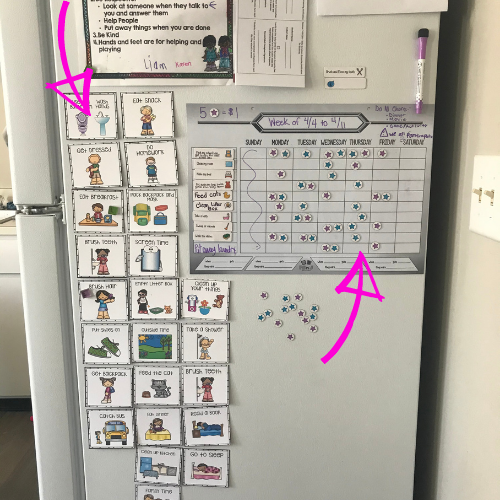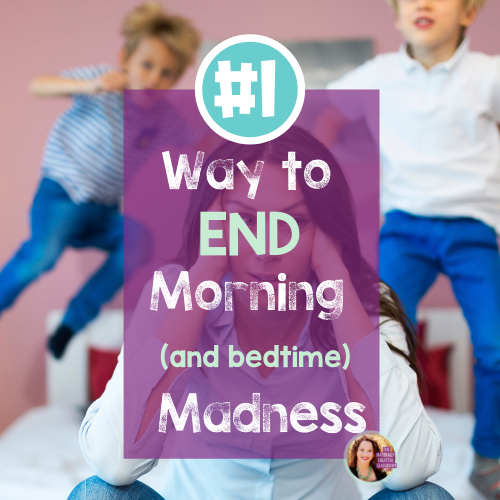Disclaimer: This post contains affiliate links and I may get compensation if you purchase after following the links.
Use a Visual Schedule to smooth out routines
Using a visual schedule has literally saved my sanity. The BEST part is kids LIKE it. Does the following sound familiar to anyone else?
Brush your teeth!
Get your shoes on!
You’re going to miss the bus!
Why haven’t you brushed your teeth yet?!
I don’t know about you, but the mornings when I have to get my kids off to school can quickly cause me frustration and anger (it’s 7:10 and you are seriously still sitting there eating cereal!?). I feel like I’m a broken record, telling my twins to do the SAME things every morning. My daughter has said, on a school morning, “but you didn’t TELL me to brush my hair.” *Sigh* you are nine, you have to do it every day…and yes, I did.
When my twins were headed off to 3 year old preschool, forget it! We know rationally that they are little and need help and direction, but in the moment, sometimes we can forget that. Like, when you have asked Liam (who is fully dressed and almost ready to leave for school) to brush his teeth for the third time and you turn around and his naked bum is hanging over the sink, his shoes are off and he is wiping toothpaste on the mirror…sometimes we forget (I was STANDING right HERE!).
Why a visual schedule?
Visual schedules have been used in elementary schools for many years, especially in K-3. They are the go-to recommendation when any individual child might have challenges staying on track in class. Our human brains like order and like to know what will come next.
Visual schedules are great for kids on the autism spectrum, but visual schedules aren’t ONLY good for kids with autism. What’s good for kids is good for kids!
Just a few benefits of Visual Schedules:
- provide predictability
- allow kids access who can't yet read
- reinforce verbal instructions
- teach sequencing
- Teach planning
- Ease transitions
- Promote responsibilty and independence
How I use my visual schedule
My own children are currently 3rd graders. I have posted the schedule on our fridge next to the chore chart. (LOVE this chore chart. You can get it here)

I haven’t added times to this as I prefer to do more of a solid “end time”. On school mornings, they know they need to be out the door by 7:30. If they are done significantly early, then they may have some free time (NOT screen time as I found my kids getting up at like 5am JUST so they could get up and play on their Nintendo before school).
For after school tasks (that start with “snack”), I say that screen time is over by 4:30pm. Then, the faster they get their homework done and pack for the next day, the more screen time they have.
I prefer a fridge chart to a clip chart and they keep track of where they are on the schedule using a small magnet with their name on them. These magnets are super strong and I use them in the classroom too. You can find them here. I also like these magnetic dry erase markers. They stay where you put them.
Cards for Before School and after school
I have included cards for all the things that I can think of in this visual schedule. It was first created it when they were preschoolers and it was kept simple. As they have gotten older, they now have more responsibilities like chores, pets to care for, as well as more school responsibilities. New cards with older kid graphics have been added to appeal to younger and older kids.
These cards cover all of the daily morning expectations of getting ready for school such as eating breakfast, brushing teeth and hair and getting your backpack ready to go. I also included after school cards such as screen time, taking care of pets, family time and outside time. Finally, I have included bedtime routine cards such as getting PJs on, reading a book and taking a bath. You can this visual schedule throughout your entire day!
Cards for Breaks
During the quarantine summer, when no one else was able to watch my kids and I had to work from home, this schedule saved me. I was able to update it along with a time schedule next to the visual schedule so that they could keep track of their activities while I worked. I was also able to quickly check what they should be doing. They knew that at 2pm I would close down my computer and we would do something together.
I added cards for creative time, independent reading time, free time, lunch and game time.
I went through a few summer schedules, and this is the one I liked best. It includes short blocks of time that change every 30 minutes to an hour. It has some learning time and plenty of choice time for them. I now turn to it for any extended breaks and will be using it again this summer.


